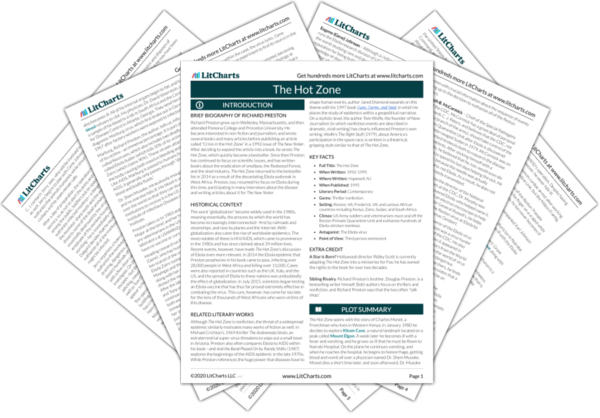Summary
Analysis
On the 13th of November, Dan Dalgard decides to consult USAMRIID about the illness in the monkey house. He contacts a virologist named Peter Jahrling, an expert on monkey viruses, who becomes curious about the mysterious malady. Jahrling has worked at the Institute for much of his professional life, but has also studied viruses in the rain forests of Central America. Trained to work in a spacesuit, he researches methods of combating hot viruses, and tries to think minimally about the diseases’ effects. Like the Jaaxes, his family lives in Thurmont. Although Jahrling lives a fairly ordinary life, the one outward sign of his profession is a vanity license plate on his car that reads LASSA. Lassa is a West African Level 4 virus that Jahrling finds fascinating, even beautiful. He has worked with almost every “hot agent” in the world except for Ebola and Marburg. When asked why, he replies, “I don’t particularly feel like dying.”
Like Gene Johnson, Karl Johnson, and Nancy Jaax, Peter Jahrling is a brave and dedicated scientist who finds viruses both horrifying and fascinating. Unlike the above three, however, Jahrling refuses to work with Ebola. It is striking that even a man who is willing to study and handle another Level 4 virus—Lassa—shies away from getting close to this one. This moment is also an instance of dramatic irony, of course, as readers are well aware that Jahrling will soon be sucked into the Ebola narrative.
Themes
The next day, Peter Jahrling receives frozen samples from O53, wrapped in flimsy aluminum foil. The ice around them is bloody and melting. He takes them into a Level 3 laboratory, which is kept under negative air pressure to keep viruses from escaping, but does not require a spacesuit. Instead, Jahrling wears a surgical mask, scrubs, and gloves. He examines the monkey’s spleen with a pathologist, and feels thankful that he’s not dealing with Marburg. Later that day, he calls Dan Dalgard and reprimands him for the sloppy condition of the sample’s packaging.
Dalgard’s sloppy delivery of O53’s samples to Jahrling makes all too clear his ignorance about the danger that he’s in. Jahrling then compounds this understandable yet perilous error by working with the virus at Level 3 rather than 4. In both cases these smart, careful men have been completely fooled by Ebola, emphasizing just how difficult it is to truly contain the virus.
Themes
A civilian technician named Joan Rhoderick cultures the virus from O53, meaning that she places it in a flask of water with living cells, and waits for it to multiply. She grinds up the spleen and puts it in one flask with monkey kidney cells, and does the same thing with O53’s mucus and blood serum. Last, she places the flasks in an incubator and waits to see if anything grows.
Preston heightens the suspense of the moment by describing in detail the way that Joan Rhoderick displays the sample for testing. Like her colleague Peter Jahrling, she is completely unaware that she is actually handling tissue infected with Ebola.
Themes
Dan Dalgard checks in with Bill Volt the next day, and learns that no monkeys have died overnight. He calls Jahrling, but is told that they won’t know anything for a few more days. A day later, Volt calls Dalgard to tell him the bad news: eight monkeys in Room F have stopped eating, and will soon die. Dalgard races to the monkey house and finds the room full of glassy-eyed, lethargic animals. Realizing that the entire room will die, he becomes anxious for news from USAMRIID. By November 16th, the virus seems to have spread to other rooms. That night, Dalgard receives a tentative diagnosis from Peter Jahrling: simian hemorrhagic fever. In order to contain the virus Dalgard and another veterinarian euthanize the rest of the monkeys, including those that appear healthy. Autopsying the healthy animals, Dalgard is upset to find that they appear perfectly fine.
The sense that the virus in the Reston monkey house is a ticking time bomb heightens during this section, as Ebola spreads while the scientists at USAMRIID actually misdiagnose the disease. This error, despite the best scientific equipment in the world, comes at the worst possible moment: just as the virus begins to spread and expand. Part of the virus’s danger, then, comes not just from its virulence, but from the confusion and mystery that surrounds it—as this making it difficult for even experienced scientists to correctly diagnose it.
Themes
Get the entire The Hot Zone LitChart as a printable PDF.

Before leaving the monkey house, Dan Dalgard and the other veterinarian place the dead monkeys in clear plastic bags and move them to a freezer. There is nothing to suggest, Preston comments, that the place is full of a hot virus. He describes the monkeys’ distorted, bloody bodies within the bags, their faces “expressionless masks.”












